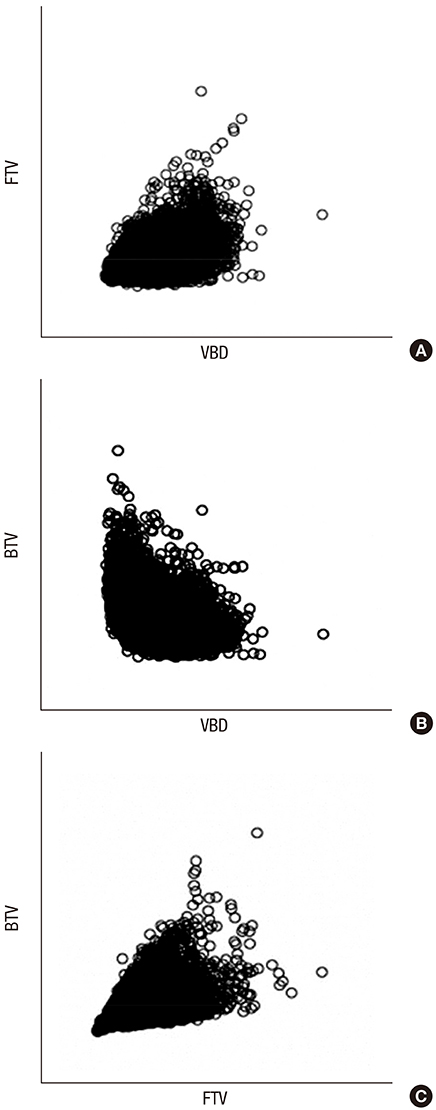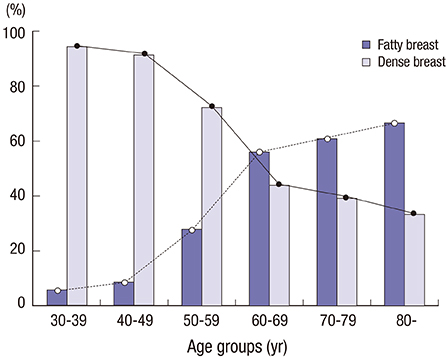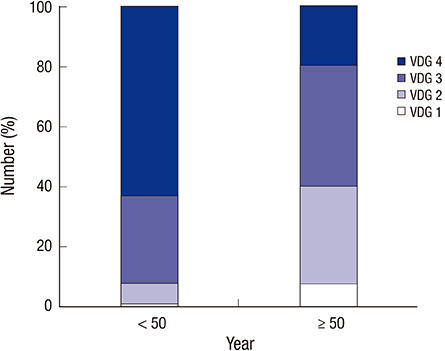J Korean Med Sci.
2016 Mar;31(3):457-462. 10.3346/jkms.2016.31.3.457.
Mammographic Breast Density Evaluation in Korean Women Using Fully Automated Volumetric Assessment
- Affiliations
-
- 1Department of Radiology, Kangbuk Samsung Hospital, Sungkyunkwan University School of Medicine, Seoul, Korea. seonhyeong.choi@samsung.com
- KMID: 2363509
- DOI: http://doi.org/10.3346/jkms.2016.31.3.457
Abstract
- The purpose was to present mean breast density of Korean women according to age using fully automated volumetric assessment. This study included 5,967 screening normal or benign mammograms (mean age, 46.2 +/- 9.7; range, 30-89 years), from cancer-screening program. We evaluated mean fibroglandular tissue volume, breast tissue volume, volumetric breast density (VBD), and the results were 53.7 +/- 30.8 cm3, 383.8 +/- 205.2 cm3, and 15.8% +/- 7.3%. The frequency of dense breasts and mean VBD by age group were 94.3% and 19.1% +/- 6.7% for the 30s (n = 1,484), 91.4% and 17.2% +/- 6.8% for the 40s (n = 2,706), 72.2% and 12.4% +/- 6.2% for the 50s (n = 1,138), 44.0% and 8.6% +/- 4.3% for the 60s (n = 89), 39.1% and 8.0% +/- 3.8% for the 70s (n = 138), and 39.1% and 8.0% +/- 3.5% for the 80s (n = 12). The frequency of dense breasts was higher in younger women (n = 4,313, 92.3%) than older women (n = 1,654, 59.8%). Mean VBD decreased with aging or menopause, and was about 16% for 46-year-old-Korean women, much higher than in other countries. The proportion of dense breasts sharply decreases in Korean women between 40 and 69 years of age.
Keyword
MeSH Terms
Figure
Cited by 3 articles
-
A Validation Study of a Multiple Reaction Monitoring-Based Proteomic Assay to Diagnose Breast Cancer
Yumi Kim, Un-Beom Kang, Sungsoo Kim, Han-Byoel Lee, Hyeong-Gon Moon, Wonshik Han, Dong-Young Noh
J Breast Cancer. 2019;22(4):579-586. doi: 10.4048/jbc.2019.22.e57.Prevalence of Women with Dense Breasts in Korea: Results from a Nationwide Cross-sectional Study
Hye-Mi Jo, Eun Hye Lee, Kyungran Ko, Bong Joo Kang, Joo Hee Cha, Ann Yi, Hae Kyoung Jung, Jae Kwan Jun
Cancer Res Treat. 2019;51(4):1295-1301. doi: 10.4143/crt.2018.297.유방외과 의사와 S-DetectTM의 유방종괴에 대한 진단수행도 비교
Haram Kim, Eiyoung Kwon, Youngsam Park, Eunhye Choi, Mijin Kim, Cheolseung Kim
J Surg Ultrasound. 2019;6(2):58-63. doi: 10.46268/jsu.2019.6.2.58.
Reference
-
1. Ellison-Loschmann L, McKenzie F, Highnam R, Cave A, Walker J, Jeffreys M. Age and ethnic differences in volumetric breast density in new zealand women: a cross-sectional study. PLoS One. 2013; 8:e70217.2. Harvey JA, Bovbjerg VE. Quantitative assessment of mammographic breast density: relationship with breast cancer risk. Radiology. 2004; 230:29–41.3. McCormack VA, Perry N, Vinnicombe SJ, Silva IS. Ethnic variations in mammographic density: a British multiethnic longitudinal study. Am J Epidemiol. 2008; 168:412–421.4. Ciatto S, Visioli C, Paci E, Zappa M. Breast density as a determinant of interval cancer at mammographic screening. Br J Cancer. 2004; 90:393–396.5. Youk JH, Kim EK. Supplementary screening sonography in mammographically dense breast: pros and cons. Korean J Radiol. 2010; 11:589–593.6. Winkler NS, Raza S, Mackesy M, Birdwell RL. Breast density: clinical implications and assessment methods. Radiographics. 2015; 35:316–324.7. Price ER, Hargreaves J, Lipson JA, Sickles EA, Brenner RJ, Lindfors KK, Joe BN, Leung JW, Feig SA, Bassett LW, et al. The California breast density information group: a collaborative response to the issues of breast density, breast cancer risk, and breast density notification legislation. Radiology. 2013; 269:887–892.8. Gweon HM, Youk JH, Kim JA, Son EJ. Radiologist assessment of breast density by BI-RADS categories versus fully automated volumetric assessment. AJR Am J Roentgenol. 2013; 201:692–697.9. American College of Radiology. BI-RADS Committee. BI-RADS® - Mammography 2013. In : Mendelson EB, Böhm-Vélez M, Berg WA, Whitman GJ, Feldman MI, Madjar H, Rizzatto G, Baker JA, Zuley M, Stavros AT, editors. ACR BI-RADS® Atlas, Breast Imaging Reporting and Data System. 5th ed. Reston, VA: American College of Radiology;2013. p. 1–173.10. Martin KE, Helvie MA, Zhou C, Roubidoux MA, Bailey JE, Paramagul C, Blane CE, Klein KA, Sonnad SS, Chan HP. Mammographic density measured with quantitative computer-aided method: comparison with radiologists’ estimates and BI-RADS categories. Radiology. 2006; 240:656–665.11. Ko SY, Kim EK, Kim MJ, Moon HJ. Mammographic density estimation with automated volumetric breast density measurement. Korean J Radiol. 2014; 15:313–321.12. Seo JM, Ko ES, Han BK, Ko EY, Shin JH, Hahn SY. Automated volumetric breast density estimation: a comparison with visual assessment. Clin Radiol. 2013; 68:690–695.13. Kim SH, Kim MH, Oh KK. Analysis and comparison of breast density according to age on mammogram between Korean and western women. J Korean Radiol Soc. 2000; 42:1009–1014.14. National Cancer Center Center for Uterine Cancer/Center for Cancer Prevention & Detection; Korea Centers for Disease Control and Prevention. Menarchial and menopausal age and health impact of menopause in Korean women. Public Health Wkly Rep. 2008; 1:1–4.15. Checka CM, Chun JE, Schnabel FR, Lee J, Toth H. The relationship of mammographic density and age: implications for breast cancer screening. AJR Am J Roentgenol. 2012; 198:W292–W295.16. Kolb TM, Lichy J, Newhouse JH. Comparison of the performance of screening mammography, physical examination, and breast US and evaluation of factors that influence them: an analysis of 27,825 patient evaluations. Radiology. 2002; 225:165–175.17. Jung KW, Won YJ, Kong HJ, Oh CM, Lee DH, Lee JS. Cancer statistics in Korea: incidence, mortality, survival, and prevalence in 2011. Cancer Res Treat. 2014; 46:109–123.18. International Agency for Research on Cancer (FR). GLOBOCAN 2012: estimated cancer incidence, mortality and prevalence worldwide in 2012. accessed on March 2015. Available at http://globocan.iarc.fr.19. Jung KW, Won YJ, Kong HJ, Oh CM, Cho H, Lee DH, Lee KH. Cancer statistics in Korea: incidence, mortality, survival, and prevalence in 2012. Cancer Res Treat. 2015; 47:127–141.20. Stomper PC, D’Souza DJ, DiNitto PA, Arredondo MA. Analysis of parenchymal density on mammograms in 1353 women 25-79 years old. AJR Am J Roentgenol. 1996; 167:1261–1265.21. Jeon JH, Kang JH, Kim Y, Lee HY, Choi KS, Jun JK, Oh DK, Lee CY, Ko K, Park EC. Reproductive and hormonal factors associated with fatty or dense breast patterns among Korean women. Cancer Res Treat. 2011; 43:42–48.22. Barlow WE, White E, Ballard-Barbash R, Vacek PM, Titus-Ernstoff L, Carney PA, Tice JA, Buist DS, Geller BM, Rosenberg R, et al. Prospective breast cancer risk prediction model for women undergoing screening mammography. J Natl Cancer Inst. 2006; 98:1204–1214.23. Nelson HD. Menopause. Lancet. 2008; 371:760–770.24. del Carmen MG, Halpern EF, Kopans DB, Moy B, Moore RH, Goss PE, Hughes KS. Mammographic breast density and race. AJR Am J Roentgenol. 2007; 188:1147–1150.25. Galukande M, Kiguli-Malwadde E. Mammographic breast density patterns among a group of women in sub Saharan Africa. Afr Health Sci. 2012; 12:422–425.26. Ishihara S, Taira N, Kawasaki K, Ishibe Y, Mizoo T, Nishiyama K, Iwamoto T, Nogami T, Motoki T, Shien T, et al. Association between mammographic breast density and lifestyle in Japanese women. Acta Med Okayama. 2013; 67:145–151.27. Tice JA, Cummings SR, Smith-Bindman R, Ichikawa L, Barlow WE, Kerlikowske K. Using clinical factors and mammographic breast density to estimate breast cancer risk: development and validation of a new predictive model. Ann Intern Med. 2008; 148:337–347.28. Gubern-Mérida A, Kallenberg M, Platel B, Mann RM, Martí R, Karssemeijer N. Volumetric breast density estimation from full-field digital mammograms: a validation study. PLoS One. 2014; 9:e85952.29. Wang J, Azziz A, Fan B, Malkov S, Klifa C, Newitt D, Yitta S, Hylton N, Kerlikowske K, Shepherd JA. Agreement of mammographic measures of volumetric breast density to MRI. PLoS One. 2013; 8:e81653.30. Highnam R, Brady SM, Yaffe MJ, Karssemeijer N, Harvey J. Robust breast composition measurement - Volpara™. In : Martí J, Oliver A, Freixenet J, Martí R, editors. Digital mammography. Berlin: Springer Berlin Heidelberg;2010. p. 342–349.
- Full Text Links
- Actions
-
Cited
- CITED
-
- Close
- Share
- Similar articles
-
- Association of Volumetric Breast Density with Clinical and Histopathological Factors in 205 Breast Cancer Patients
- Mammographic Density Estimation with Automated Volumetric Breast Density Measurement
- Mammography with a fully automated breast volumetric software as a novel method for estimating the preoperative breast volume prior to mastectomy
- Changes in Automated Mammographic Breast Density Can Predict Pathological Response After Neoadjuvant Chemotherapy in Breast Cancer
- Estimation of the Relative Risk for Breast Cancer in Korean Women Using Gail Model





